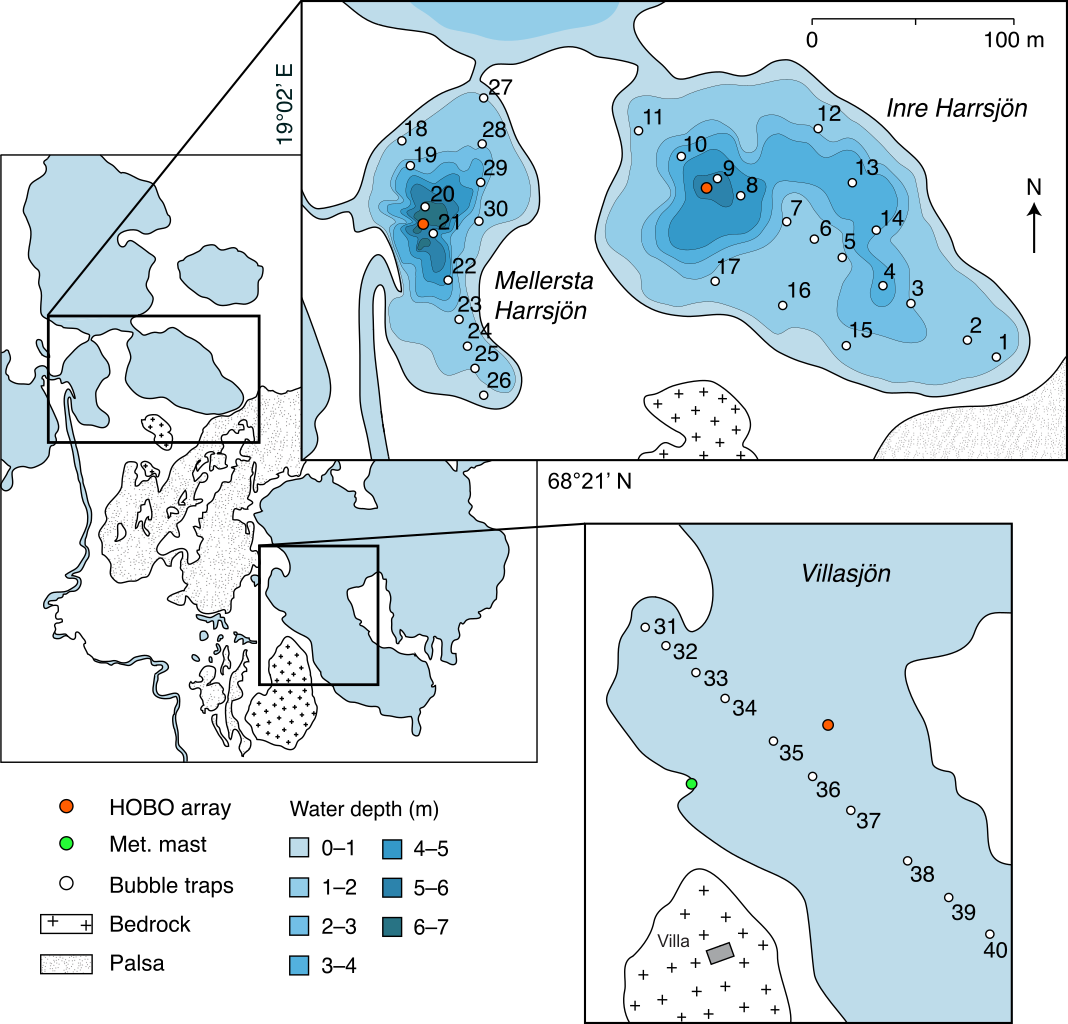Joachim Jansen, Martin Wik, Patrick Crill
This dataset provides measurements of the bubble flux of methane (CH₄), a strong climate forcing trace gas, to the atmosphere from three subarctic lakes located on the Stordalen Mire in northern Sweden.
Ebullition rates of gas bubbling from the lake sediments containing mostly CH₄ was measured with bubble traps during the ice-free seasons of 2009 to 2017. The lakes are small (surface area 0.010 – 0.17 km²) and shallow (max. depth 1.3 – 6.7 m), and are structural features of the landscape (i.e. non-thermokarst, glacial). Up to 40 bubble traps were continuously deployed across the different depth zones and sampled (emptied of gas) every 1– 3 days to capture the erratic or variable nature of bubble gas release. CH₄ concentrations were measured using a gas chromatograph. Flux was computed from the CH₄ concentration of gas volume that had accumulated during the trap deployments. Measurements of a subset of the isotopic composition of the trapped CH₄ (δ¹³C-CH₄ and δ²H-CH₄) are included as is the surface sediment temperature at the time of sampling are also included. This is a unique data set in both its spatial and temporal resolution and length.
The measurements have been used to assess the environmental drivers of CH₄ emissions from lakes to the atmosphere, and how emissions might change under continued Arctic warming.
Note that this is an outdated revision of the dataset and there is an
updated version.
Citation
Joachim Jansen, Martin Wik, Patrick Crill (2020) Methane bubble fluxes from subarctic lakes on the Stordalen Mire, Abisko, Northern Sweden. Dataset version 3. Bolin Centre Database. https://doi.org/10.17043/stordalen-lakes-ch4-ebul-3
References
Wik M, Crill PM, Varner RK, Bastviken D. (2013). Multiyear measurements of ebullitive methane flux from three subarctic lakes, Journal of Geophysical Research: Biogeosciences, 118, 1307 – 1321. https://doi.org/10.1002/jgrg.20103
Jansen J, Thornton BF, Wik M, MacIntyre S, Crill PM. (2020). Temperature proxies as a solution to biased sampling of lake methane emissions. Geophysical Research Letters, 47. https://doi.org/10.1029/2020GL088647
Wik M, Thornton BF, Varner RK, McCalley C, Crill PM. (2020). Stable methane isotopologues from northern lakes suggest ebullition is dominated by sub-lake scale processes. Journal of Geophysical Research - Biogeosciences, accepted
Data description
This dataset consists of one .csv file (data), two .png files (map of the sampling locations and photos of the bubble trap) and one .pdf file (readme).
The data are derived multiyear measurements of methane (CH₄) bubble fluxes from 2009 – 2017 (n = 14677) and a subset of those gas collections taken between 2009-2011 and analyzed for δ¹³C-CH₄ (n = 177) and δ²H-CH₄ (n = 251) from three small subarctic lakes in the Stordalen Mire complex.
The Mire is located ca. 10 km east of Abisko, in northern Sweden (68°21′N, 19°02′E). Bubble traps were continuously deployed from June to September during the ice-free seasons across depth zones of the lakes and sampled (volume measure and gas removed from the traps) every 1-3 days of 2009 to 2017. Paired surface sediment temperatures were computed from HOBO Water Temp Pro V2 temperature loggers (Onset Computer) deployed at different depths at the deepest point in each of the lakes. The water column temperature data are available in the dataset Temperatures in subarctic lakes on the Stordalen Mire, Abisko, Northern Sweden.
For details about the sampling procedure and locations, please refer to the Stordalen lake flux publications by Wik et al. (2013), Jansen et al. (2020), Wik et al. (2020); see References.
The csv data file (character set: UTF-8) has one header row and 15129 rows of data. There are twelve (12) data columns. NaN denotes data missing for any reason. The headers should be self-explanatory but please read the readme pdf for further information.
Comments
Please, cite both the data set itself and the appropriate publications by Wik et al. (2013), Jansen et al. (2020), Wik et al. (2020) (see References) when using these data. The principal investigators (Joachim Jansen, Martin Wik, Patrick Crill) would also welcome notification when the data are used in any publication or derivative work.
Version history
Version 3
Added isotope data to the dataset csv file. Fixed errors in the sampling time stamps for DOY. Included an additional image file (photos of bubble trap).
Version 2
Initial release.
Version 1
Not published. Used in the Wik et al. (2013) paper and has fewer years (2010 – 2014).
